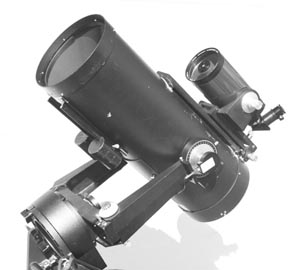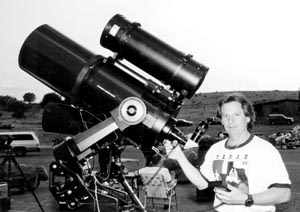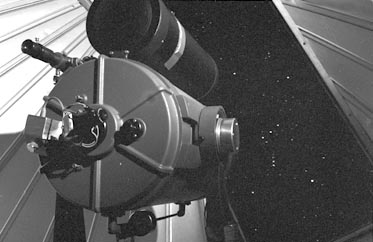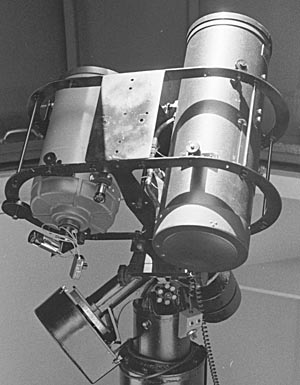Part II: Collimating and Focusing the Celestron/Epoch Schmidt Camera

The Schmidt camera is a rugged instrument being simple in design with no
moving parts to wear out or break. The camera's focus is preset at the
factory and without interference of some catastrophic event, the Schmidt
camera will retain its precise infinity focus virtually forever. However, in
the real world, the camera is transported, handled, and subjected to
variations in temperature and humidity which all conspire to eventually
alter the instrument's focus and collimation.
The term collimation means placing the mirror, corrector plate, and film
holder on axis and not tilted relative to each other. Focus means proper
placement of the mirror and film holder relative to each other.
If the camera is out of collimation, star images will be comatic, or flared
and comet-like in one direction over the entire field. If the camera is out
of focus, star images will be fuzzy or swollen, sometimes showing the shadow
of the film holder at the center of the bloated star image. The image may
not necessarily be out of focus over the entire field. In an extreme case,
such as a tilted mirror, the camera can be out of collimation and out of
focus at the same time.
 A quarter century of use eventually softened the focus on my Schmidt and
forced me to research the techniques of servicing the Celestron/Epoch
Schmidt camera. Since all other owners of these instruments are also now
without factory support, I decided to chronicle my efforts to repair my
8-inch Schmidt as to guide others in the repair of their own Schmidt
cameras.
I should say that my experiences are with the original Celestron 8-inch
Schmidt camera, not the 5.5-inch or the modified version that has been
upgraded by Epoch Instruments with a different mirror cell and spider
assembly. References to design or assembly differences in the Epoch Schmidt
cameras as opposed to the Celestron models are gathered from anecdotal
information provided by owners of these instruments.
There are a number of critical measurements in a Schmidt camera. The curve
of the film holder must be actly concentric with the curve of the mirror.
The distance from the mirror to the film holder must be equal between the
mirror and the center of the film holder and the mirror and the edges of the
film holder. The mirror, film holder, and corrector plate must be on-axis
and collimated. If any of these measurements are incorrect, the camera will
be out of focus. In fact, an f/1.5 Schmidt camera is sensitive to focus
variations of only .001 inch.
A quarter century of use eventually softened the focus on my Schmidt and
forced me to research the techniques of servicing the Celestron/Epoch
Schmidt camera. Since all other owners of these instruments are also now
without factory support, I decided to chronicle my efforts to repair my
8-inch Schmidt as to guide others in the repair of their own Schmidt
cameras.
I should say that my experiences are with the original Celestron 8-inch
Schmidt camera, not the 5.5-inch or the modified version that has been
upgraded by Epoch Instruments with a different mirror cell and spider
assembly. References to design or assembly differences in the Epoch Schmidt
cameras as opposed to the Celestron models are gathered from anecdotal
information provided by owners of these instruments.
There are a number of critical measurements in a Schmidt camera. The curve
of the film holder must be actly concentric with the curve of the mirror.
The distance from the mirror to the film holder must be equal between the
mirror and the center of the film holder and the mirror and the edges of the
film holder. The mirror, film holder, and corrector plate must be on-axis
and collimated. If any of these measurements are incorrect, the camera will
be out of focus. In fact, an f/1.5 Schmidt camera is sensitive to focus
variations of only .001 inch.

Go to the previous page ---- Pros and Cons of a
Schmidt Camera
Go to the next page -------- Initial Inspection







